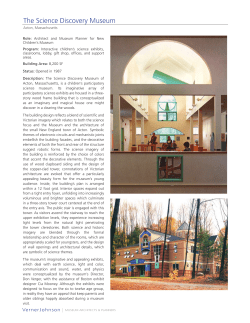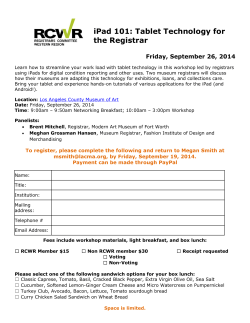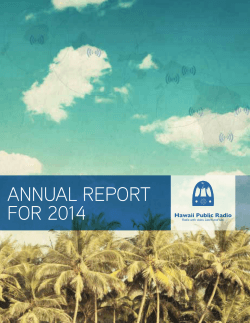
Education Department - The Bernice Pauahi Bishop Museum
■ ON E XHIBIT 1 Sewing class at Kawaiaha‘o Seminary, Honolulu, ca. 1909 (Bishop Museum) Label for can of Dole Sliced Pineapple packed in Honolulu, 1934 (Private collection) 2 3 4 5 6 The first Pacific telegraph cable is brought ashore at Sans Souci beach, Waikīkī, 1902 (Bishop Museum) ED U C AT I O N ■ Online Multimedia Resources for Teachers D e c e m b e r 1 3 , 2 0 1 4 – M a r c h 1 6 , 2 0 1 5 • J . M . L o n g G a ll e r y Trade Winds Tours employees and bus, Honolulu, 1975 (Private collection) President John Kennedy (center), Governor John Burns (left) and Senator Daniel Inouye (right) in a motorcade through Honolulu, 1963 (Edward Johnstone, 1 ca. 1909 Cane toad, or Bufo, near a stream below Tripler Army Medical Center, Honolulu, 2005 (David Preston) 2 1934 4 1975 3 1902 Mahalo to our sponsors: 5 6 12 Ka ‘Elele Winter 2015 2005 1963 Geographic isolation has long been a challenge for those living outside of the island of O‘ahu in accessing the many education focused resources offered by the Bishop Museum. The Bishop Museum Education Online Learning Center (OLC) hopes to serve as a ‘digital’ bridge for educators seeking these resources. Since the fall of 2013, the Museum’s Education Department have worked to create, design and implement a website and database search engine that would best meet the needs of educators. Written curricula and other multimedia resources are available via the site such as interactive images, videos, lessons, and games. A great example is the 360-degree interactive image of the ‘Wind Gourd of La‘amaomao,’ which is currently housed in the Bishop Museum Culture Collections. The ‘Wind Gourd of La‘amaomao’ is featured in the middle school curriculum unit ‘Mana Makani: The Power of the Wind.’ The online interactive provides a visual for teachers to use with students while exploring concepts of meteorology drawing on how Polynesian navigators apply traditional and modern skills to sail the Pacific ocean. The key criteria being that the site is accessible, searchable, and easy to use for educators to incorporate in their lesson plans. Tests to determine if the site was able to accomplish these goals were conducted with teachers and informal educators throughout the state of Hawai‘i. All participants had varying abilities and comfort with technology to ensure that there would be no limitations with the web-based platform. A usability test with four teachers on the island of Moloka‘i revealed significant limitations for the site, when a major storm system reached the island the night before the usability test. The resulting challenges presented limitations with bandwidth and internet reliability in certain areas which led to a major shift in the design of the site. The site now allows for resources to be acccessed ‘offline.’ This avoids any delays in using the curricula and other online content in classrooms or other venues where internet access may not be reliable. The Online Learning Center has been launched as part of the Department of Education Native Hawaiian Program (DOE NHEP) ‘All Together Now’ and NASA Celestial Island project. Though in its infancy, the long term goal is to serve as an access point for other Bishop Museum related education resources. To find digital resources on the Natural Science and Culture of Hawai‘i and Pacific go to www.bishopmuseumeducation.org to by Amber Inwood start your search! LEFT | Follow the Word – An online interactive lesson for students looking at the Polynesian migration routes and languages in the Pacific. ARTWORK | Click Hawaiian® Art, © 1996–2001 Varez/Coconut Info Meaning of Mālama Honua by Hadley Andersen The first sphere cast event for the Polynesian Voyaging Society’s World Wide Voyage was about the effects of climate change on Pacific islands and Hōkūle‘a’s mission of Mālama Honua (taking care of the Earth). The sphere cast was broadc ast last September from Pago Pago, American Sāmoa to Bishop Museum in Honolulu and at ‘Imiloa Observatory on Hawai‘i Island. The presentation was given to students from Hawai‘i and American Sāmoa. Students from Ka Waihona o Ka Na‘auao Public Charter School were able to talk with students from Matafao Elementary School in American Sāmoa and from Kea‘au Middle School on Hawai‘i Island about what Mālama Honua means to them. PVS, NOAA and the Hawaii Department of Education are looking into the viability of doing more programs using the Science on a Sphere as a tool to teach students about the World Wide Voyage. The technology is quickly evolving and if this last sphere cast event is any indication of how impactful this tool can be, expect to see Bishop Museum involved in more of these events in the future. Ka ‘Elele Winter 2015 13
© Copyright 2025




















